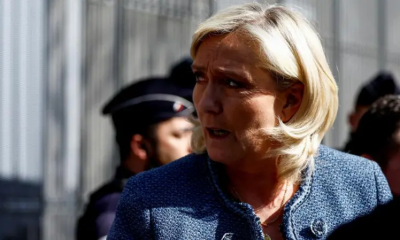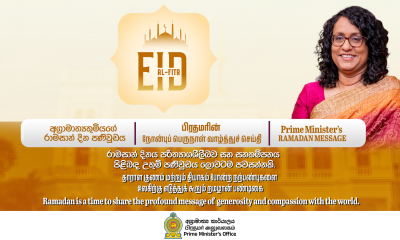Midweek Review
first major political crisis since 2019 prez poll
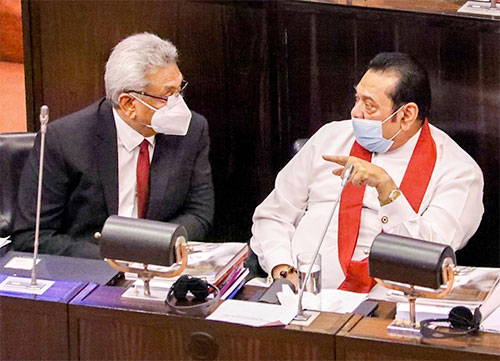
President Gotabaya Rajapaksa and Premier Mahinda Rajapaksa in conversation in Parliament on Feb 11, 2021. It was President Gotabaya Rajapaksa’s fourth visit to Parliament since the inauguration of the new session (pic courtesy PMD)
By Shamindra Ferdinando
National Freedom Front (NFF) leader, Wimal Weerawansa, MP, recently caused quite a political storm by calling for the inclusion of President Gotabaya Rajapaksa in Sri Lanka Podujana Peramuna (SLPP) decision-making hierarchy. In spite of efforts to settle the issue, amicably, strong statements made by SLPP Chairman Prof. G.L. Peiris and its General Secretary Sagara Kariyawasam at the regular weekly media briefing at Waters’ Edge underscored the simmering problem (report on media briefing on page 1)
Weerawansa’s call triggered an extremely angry response from the ruling SLPP with its General Secretary Sagara Kariyawasam lambasting the former JVPer. Flanked by Kalutara District SLPP MP Sanjiva Edirimanne and SLPP Administrative Secretary Renuka Perera, Attorney-at-Law Kariyawasam dismissed Weerawansa’s call.
The briefing at the SLPP Nelum Mawatha Office, Battarmulla, revealed unprecedented deep resentment towards Weerawansa whose unexpected appeal took the SLPP by total surprise. Newcomers Kariyawasam, a National List MP and Edirimanne, who polled 105,973 preference votes in the Kalutara district at the last parliamentary election in August 2020, teamed up with Perera. The SLPP ‘blitz’ shook the political scene.
The SLPP primarily targeted Weerawansa on two issues, namely the NFF leader had no right whatsoever to call for removal of SLPP leader Prime Minister Mahinda Rajapaksa and the NFF maintained clandestine links with two foreign intelligence agencies.
A section of the media thrived on the unexpected political controversy caused by Weerawansa. The former JVP Propaganda Secretary couldn’t have made that call without realizing the far reaching consequences. Those seeking to exploit the SLPP-NFF dispute tried to capitalise on the situation. The SLPP, too, contributed to that strategy. In its haste to attack Weerawansa over his interview with the Lankadeepa in its Feb 7, 2021 edition, the SLPP forgot the NFF leader wanted a specific political role for President Gotabaya Rajapaksa.
Does President Gotabaya Rajapaksa require a political role? Does he deserve such a role? Can President Rajapaksa be denied a leadership role in the SLFP, undoubtedly the most powerful political party today? Can Gotabaya Rajapaksa ‘operate’ outside the SLPP, thereby depriving him an opportunity to intervene in political matters?
Media ‘blitz’
The SLPP’s drastic response to Weerawansa’s timely suggestion underscored President Gotabaya Rajapaksa lacking much needed political clout. Over a year after the last presidential election in Nov 2019, President Gotabaya Rajapaksa remained a man without SLPP membership. In fact, the SLPP on its own should have considered how to accommodate President Gotabaya Rajapaksa. Had the SLPP acted wisely, Weerawansa wouldn’t have had to risk a preventable political crisis. The SLPP actually owed an explanation why it failed to consider a suitable position within the hierarchy. It would be pertinent to mention that Weerawansa secured two other interviews on Feb 7, the day the Lankadeepa published the controversial discussion. Mawbima, published by the Ceylon Newspapers Pvt Limited owned by SLPP National List MP Tiran Alles and Communist Party mouthpiece, ‘Aththa’ (Truth), a name borrowed from the former official Soviet CP newspaper Pravda.
The writer found the Aththa interview conducted by its Editor (name not given) quite critical of the incumbent Rajapaksa administration. In fact, Weerawansa therein asserted that there had been much better internal discussion within the SLFP-led coalition during the previous Rajapaksa presidency (Nov 2005-January 2015). There had been no reference to President Gotabaya Rajapaksa being given a political role whatsoever. The NFF leader who spearheaded a campaign within the SLPP against the hotly disputed government decision to hand over to India 49 per cent stake in the East Container Terminal (ECT) at the Colombo port, in Feb 3, 2021 sought to explain the common stand taken by some parties within the SLPP. Instead, Weerawansa created an enormous political issue that overwhelmed the ruling coalition.
Perhaps, someone should remind Weerawansa how he fired the first salvo against the previous Rajapaksa administration by seeking a consensus with the late Ven. Maduluwawe Sobitha. The meeting in the second week of July 2014 set in motion a spate of events leading to SLFP General Secretary Maihripala Sirisena switching allegiance to UNP leader Ranil Wickremesinghe.
Attack on influential clique
Responding to an Aththa query, Weerawansa explained the weaknesses in the SLPP. Alleging the absence of a regular discussion among constituents of the SLPP, Weerawansa said that though all contributed to the overwhelming victories at the 2019 and 2020 national elections, today a small clique sustained the power. When the actions of that clique caused trouble, the administration sought the help of all others to face the crisis. Declaring he had made his position clear on the extremely unhappy situation, Weerawansa alleged that the government suffered due to lack of internal discussions. Compared to the situation today, the previous Rajapaksa administration handled internal issues better. The views expressed at that time received some recognition. The absence of internal discussions had resulted in challenges to the incumbent administration.
Asked to comment on some SLPP constituents taking a common stand on the ECT issue leading to the SLPP targeting the NFF leader, Weerawansa said that representatives, including lawmakers met at his official residence on January 30, 2021, to take a common stand on the issue at hand. Altogether 10 political parties had participated in the discussion and, at the conclusion, they decided to continue with the grouping. “We decided to meet once a month to discuss developments. Discuss required changes. Discuss the government strategies,” Weerawansa said, revealing they reached a common understanding meant to bring both the government and the country under pressure. The Minister declared that at that time they met to discuss ECT exclusively, subsequently a decision was made to continue with the project. Weerawansa said that they would try to obstruct those trying to take President Gotabaya Rajapaksa on a wrong path.
Weerawansa, in his interview with Aththa, emphasised how the Western powers went even to the extent of exploring the imposition of economic sanctions on Sri Lanka against the backdrop of the 46th session of the Geneva-based United Nations Human Rights Council (UNHRC) at a time the country was mired in a deepening crisis due to rising foreign debt. Weerawansa didn’t mince his words when he acknowledged daunting economic challenges and the failure on the part of the government to achieve the much-touted economic objectives. Weerawansa blamed the Covid-19 pandemic mainly for the economic downturn. The former JVP heavyweight warned of dire consequences if the country couldn’t raise over USD 4 bn annually to settle loans obtained by successive governments, particularly the previous yahapalana administration taking commercial loans at high interest rates. Weerawansa alleged the UNP-SLFP administration went for excessively costly loans in the wake of their humiliating defeat at the last Local Government elections on Feb 10, 2018.
In other words, Weerawansa acknowledged that there couldn’t be any justification in ‘boru shows’ at a time of the rapidly developing crisis that could overwhelm the national economy. It would be the responsibility of the SLPP to ensure political stability both in and outside Parliament. An internal crisis within the SLPP now can cause irreparable damage.
Time for politics
Wartime Defence Secretary Gotabaya Rajapaksa entered active politics in the wake of the enactment of the 19th Amendment to the Constitution in 2015. The 19th Amendment deprived President Mahinda Rajapaksa of an opportunity to seek a third presidential term. One-time SLFP strongman and war-winning President Mahinda Rajapaksa failed in his hotly challenged bid to secure a third term in 2015. Having launched civil society groups Viyathmaga and Eliya at the onset of the yahapalana administration, Gotabaya Rajapaksa slowly but steadily pursued a political strategy that ultimately paved the way for him to secure the SLPP’s presidential nomination in August 2019. Yet, Gotabaya Rajapaksa didn’t publicly receive SLPP membership. Gotabaya Rajapaksa launched Viyathmaga in early 2016 to take his message to the masses. Viyathmaga was followed by Eliya that focused on countering moves to introduce a new Constitution at the expense of the country’s unitary status.
Viyathmaga emerged as an influential group within the SLPP parliamentary group with eight out of nine contestants gaining entry into Parliament at the August 2020 general election. The SLPP won 145 seats, including 17 National List slots. The Parliament comprises 196 elected and 29 appointed members.
Of the SLPP winners, retired Rear Admiral Sarath Weerasekera (328,092) and Dr. Nalaka Godahewa (325,479) polled the highest preferential votes in Colombo and Gampaha electoral districts, respectively. President Gotabaya Rajapaksa fielded the group on the SLPP ticket whereas former Central Bank Governor Ajith Nivard Cabraal and Dr. Seetha Arambepola were accommodated on the National List.
Of the successful Viyathmaga members, only Weerasekera has represented Parliament before having served the Navy for over three decades and retired as its Chief of Staff. Weerasekera represented Digamadulla electorate during Mahinda Rajapaksa’s second tenure (2010-2015) as the President.
Viyathmaga nominees Prof. Channa Jayasumana (Anuradhapura/133,980), Gunapala Ratnasekera (Kurunegala/141,991), Nalaka Kottegoda (Matale/71,404), Tilak Rajapaksha (Digamadulla/54,203), Dr. Upul Galappatti (Hambantota/63,369), and Udayana Kirindigoda (Mahanuwara/39,904) entered Parliament at the expense of those who represented the last Parliament on the UPFA ticket.
Viyathmaga nominated Businessman Anura Fernando who nursed Colombo (north) electorate failed to get elected, whereas Ali Sabri, PC, who also served Viyathmaga, was accommodated in Parliament through the SLPP National List and not as a member of Viyathmaga.
Can the SLPP continue to ignore the need to bring in President Gotabaya Rajapaksa, formally into the decision- making apparatus of the SLPP?
Mahinda Rajapaksa switched his allegiance from the SLFP to the SLPP less than two weeks after the constitutional coup staged by the then President Maithripala Sirisena in late Oct 2018. Mahinda Rajapaksa received membership on Nov 11, 2018 from SLPP Chairman Prof. G.L. Peiris in the presence of its General Secretary Sagara Kariyawasam. The well attended event took place at Premier Rajapaksa’s official residence at Wijerama Mawatha. Thirty other UPFA lawmakers received SLPP membership on that day.
MR takes SLPP membership
Mahinda Rajapaksa made the surprising move, close on the heels of the Supreme Court suspending President Sirisena’s decision to dissolve Parliament on the night of Nov 9, 2018, and called the general election on January 5, 2019. Sirisena had no other option after the then Joint Opposition and SLFP failed pathetically to prove a simple majority in Parliament. Violence caused by the Joint Opposition in Parliament didn’t serve any purpose other than to bring the entire parliamentary system to disrepute.
The Supreme Court issued its ruling on Nov 14, 2018. Among those who moved the Supreme Court were the UNP, TNA and the JVP. A jubilant UNP leader Ranil Wickremesinghe, while hailing the Court ruling, tweeted that the people have won their first victory. “Let’s go forward and re-establish the sovereignty of the people in our beloved country.”
If the SC ruling went against those who moved the Court, perhaps the political situation would have been much different today. The political situation would have been fashioned on the outcome of the January 5, 2019 general election. Perhaps, the UNP on its own could have secured the largest block of seats in Parliament and form a government with the support of a section of SLFP lawmakers with or without Sirisena. In the last Parliament the UNP had 106 elected under the ‘Elephant’ symbol. The January 5, 2019 general election would have thwarted a disastrous split in the UNP a year later that ultimately led to annihilation of the UNP at the August 2020 general election. The UNP managed to secure just one National List slot. It would be pertinent to examine whether the National Thowheed Jamaat (NTJ) resorted to the Easter Sunday carnage on April 21, 2019 if the general election was held on January 5, 2019 as envisaged by President Sirisena.
Top academic Rajan Hoole speculated in his immensely interesting and controversial ‘Sri Lanka’s Easter Tragedy: When the Deep State Gets Out Of Its Depth’ launched in the run-up to the 2019 Nov presidential election how the failure on the part of the NTJ to secure parliamentary representation at the 2015 general election may have led to the Easter Sunday attacks. If general election was held as President Sirisena wanted the NTJ would have had an opportunity to secure some of its people elected to Parliament via Muslim political parties. Had that happened, perhaps it wouldn’t have resorted to the Easter Sunday attacks, he reasoned.
Who knows spice merchant Mohamed Yusuf Ibrahim whose sons detonated explosives at the Shangri-La and the Cinnamon Grand hotels on April 21 would have found a place in the Parliament. The JVP never explained why Ibrahim was accommodated on its National List at the 2015 general election.
Ibrahim’s sons — identified as Ilham Ahmed Ibrahim and Imsath Ahmed Ibrahim —detonated their explosives at the Shangri-La and the Cinnamon Grand hotels, respectively.
Gotabaya Rajapaksa’s emergence as the SLPP presidential candidate should be examined against the backdrop of an extremely sensitive political environment following the Easter Sunday carnage. The UNP, the SLFP, JVP, TNA and all political parties represented in Parliament played politics with the issue. A naïve government allowed extremists to go on the rampage weeks after the Easter attacks. The failure to protect the Muslims is definitely as bad as allowing the NTJ to strike in spite of specific warnings received from India. The government never explained how extremists stormed Minuwangoda in the second week of May, 2019. The then Army Commander Lt. Gen. Mahesh Senanayake, having failed to prevent the Easter Sunday attacks and anti-Muslim violence, exploited the situation to seek a political career. The Army Commander, too, should have been held responsible for both failures as he also had at his disposal one of the country’s biggest intelligence operations run by the DMI. Senanayake who couldn’t even secure 50,000 votes at the last presidential election, contrary to much publicized promises, refrained from contesting the last parliamentary election. Perhaps he reslised that he had already been badly exposed.
19 A paves the way for GR
If not for the 19th Amendment, Gotabaya Rajapaksa wouldn’t have received SLPP nomination even though a significant section of the electorate appreciated the wartime Defence Secretary’s entry into politics at the highest level. Lawmakers Kumara Welgama, an SLFP heavyweight and Democratic Left Front (DLF) leader Vasudeva Nanayakkara opposed Gotabaya Rajapaksa’s entry. Welgama had the strength not only to take a public stand against Gotabaya Rajapaksa’s emergence as the SLPP candidate but switched his allegiance to the newly formed Samagi Jana Balavegaya (SJB) at the parliamentary election. Welgama entered Parliament from Kalutara.
In utterly appalling Sri Lankan politics, the country shouldn’t be surprised to see the bankrupt SJB and the JVP trying to exploit Weerawansa’s declaration. State Minister Ajith Nivard Cabrral recently reminded the real status of the SJB. Responding to SJB leader Sajith Premadasa’s query on the Katuwana branch of the Bank of Ceylon granting D.S. Gunasekera Company Rs 3.1 bn loan, a smiling former Central Bank Governor asked Premadasa where was he when the BOC subsequent to the then government’s intervention granted the Perpetual Treasuries Limited (PTL) a staggering Rs 10 bn in 10 minutes.
Premadasa formed the SJB after losing to Gotabaya Rajapaksa at the last presidential poll. A section of the civil society in a shameless bid, obviously on behalf of the UNP, moved the judiciary against Gotabaya Rajapaksa claiming he was not eligible to contest. A highly jittery SLPP fielded the then UPFA MP Chamal Rajapaksa as an independent candidate in case Gotabaya Rajapaksa suffered an unthinkable setback. The judiciary ruled in favour of Gotabaya Rajapaksa and the rest is history.
The government tackled the crisis caused by Weerawansa’s intervention. Tourism Minister Prasanna Ranatunga visited the ‘Made in Sri Lanka exhibition’ on Feb 12 on Minister Weerawansa’s invitation where he declared the issue has been settled while issuing a warning to smaller parties. On the following day, Premier Mahinda Rajapaksa visited the exhibition on Weerawansa’s invitation as the top leadership sought to settle the dispute. The SLPP initially hit back hard by calling a media briefing at Ape Gama on Feb 11 where Sanjiva Edirimanna, MP and several others strongly opposed the NFF’s intervention in what they called an internal matter. The government needs to examine contentious matters seriously. In addition to Weerawansa’s stand on the ECT and comment on the SLPP leadership, the former JVP firebrand clashed with the SLPP over the original 20th Amendment as well as an alleged attempt to influence NFF lawmakers. The clash between Weerawansa and SLPP National List MP Jayantha Ketagoda in Premier Rajapaksa’s presence in Parliament highlighted the torrid relationship between the two parties. Obviously all is not well within the ruling coalition. Those who exercised their franchise for the SLPP in 2019 and 2020 expect the ruling coalition to address internal issues, swiftly and decisively or be ready to face the consequences.
Midweek Review
Batalanda and complexities of paramilitary operations
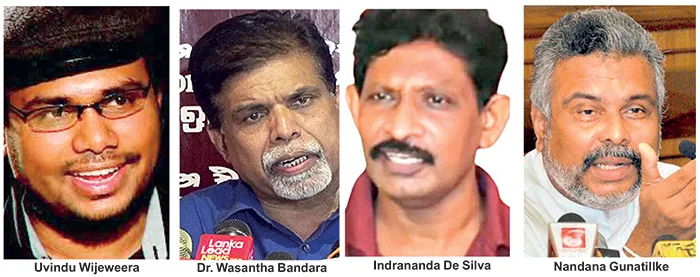
Former President Ranil Wickremesinghe’s recent combative ‘Head-to-Head’ interview with British-American Mehdi Hasan on Al Jazeera has opened a can of worms. As to why Hasan raised the Batalanda Presidential Commission report, during a 49-minute interview conducted at the London’s Conway Hall, with a clearly pro LTTE audience, remains a mystery. This must be yet another notorious way to show how even-handed they are as in the case of its coverage of Russia, China, Palestine or Ukraine for their gullible viewers.
Recorded in February and aired in March 2025, the interview is definitely the most controversial the UNP leader, who is also an Attorney-at-Law, ever faced during his political career; always used to getting kid glove treatment, especially after taking over the party in 1994.
The continuing public discourse on Batalanda should provoke a wider discussion on Sri Lanka’s response to separatist Tamil terrorism, since the cold blooded murder of Jaffna SLFP Mayor Alfred Duriappah, which signalled the beginning of the LTTE terror campaign that ended in May 2009 with the crushing military defeat of the Tigers on the banks of the Nathikadal lagoon, as well as two southern insurgencies in 1971 and 1987-1990.
As Nandana Gunatilleke (one time JVP General Secretary and ex-MP), Dr. Wasantha Bandara (ex-JVPer and close associate of the slain JVP leader Rohana Wijeweera), Indrananda de Silva (ex-JVPer, incumbent Central Committee member of Frontline Socialist Party [FSP] and ex-military photographer) and Uvindu Wijeweera (Rohana Wijeweera’s son and leader of Dewana Parapura) agreed during the recent Hiru ‘Balaya’ discussion, conducted by Madushan de Silva, the Batalanda operation was in line with the overall counter-terrorist/insurgency strategy of the then government.
The issues at hand cannot be discussed at all without taking into consideration the JVP terrorism that, at one-time, almost overwhelmed the UNP’s unbroken rule, since 1977, carried out while openly brushing aside most of the universally accepted genuine parliamentary norms. The country’s second Republican constitution, promulgated by the UNP regime with a 5/6 majority in Parliament, in 1978, had been amended no less than 13 times by the time they were finally ousted in 1995. This was mainly to facilitate their continuous rule. Unfortunately, all stakeholders have sought to take advantage of Batalanda, thereby preventing a proper dialogue. Quite surprisingly, none of the guests, nor the interviewer, bothered, at least, to make a reference to the JVP bid on President J.R. Jayewardene’s life in Parliament on the morning of July 18, 1987. At the time, JVPer Ajith Kumara, working in the House as a minor employee, hurled two hand grenades towards JRJ, with the then Prime Minister Ranasinghe Premadasa seated next to JRJ. While one government MP lost his life, several others suffered injuries, including then National Security Minister Lalith Athulathmudali, whose spleen had to be removed.
At one point, Gunatilleke declared that they assassinated UNP MP for Tangalle Jinadasa Weerasinghe on July 3, 1987, in response to the government killing well over 100 people, in Colombo, protesting against the signing of the Indo-Lanka accord on July 29, 1987. The parliamentarian was killed near the Barawakumbuka-Welangahawela bridge on the Colombo-Rathnapura-Embilipitiya Road. The UNPer was killed on his way home after having declined Premier Premadasa’s offer to make an SLAF chopper available for him to reach home safely.
Against the backdrop of MP Weerasinghe’s assassination and the grenade attack on the UNP parliamentary group that claimed the life of Keethi Abeywickrema (MP for Deniyaya), the government had no option but to respond likewise. The operation, established at the Batalanda Housing scheme of the State Fertiliser Corporation, constituted part of the counter-insurgency strategy pursued by the UNP.
Those who called Batalanda complex Batalanda torture camp/ wadakagaraya conveniently forgot during the second JVP inspired insurgency, the military had to utilize many public buildings, including schools, as makeshift accommodation for troops. Of course the UNP established Batalanda under different circumstances with the then Industries Minister Ranil Wickremesinghe providing political authority. Batalanda had been an exclusive police operation though the Army had access to it whenever a requirement arose.
Those who had been suddenly withdrawn from the Northern and Eastern Provinces, to meet the rapidly evolving security threat in the South, required accommodation. FSP CC member Indrananada de Silva had received unhindered access to Batalanda in his capacity as a military photographer and the rest is history.
As to why Indrananda de Silva switched his allegiance to the FSP should be examined, taking into consideration his previous role as a trusted military photographer, formerly a Lance Corporal of the Military Police. An influential section of the JVP, led by Kumar Gunaratnam, formed the FSP in April 2012 though it didn’t receive the much anticipated public support. Both Indrananda de Silva and Nandana Gunatilleke, who aligned himself with the UNP, found fault with the JVP-led National People’s Power (NPP) over its handling of the Batalanada issue.
Paramilitary operations
Paramilitary operations had been an integral part of the overall counter-insurgency campaign, directed at the JVP responsible for approximately 6,600 killings. Among those death squads were PRRA primarily drawn from the SLMP (Sri Lanka Mahajana Party) and SRRA (the socialist Revolutionary Red Army). PRRA had close links with the Independent Student Union (ISU) whose leader Daya Pathirana was slain by the JVP. The vast majority of people do not remember that Daya Pathirana, who led the ISU during the turbulent 1985-1986 period, was killed mid-Dec. 1989. The second insurgency hadn’t started at that time though the JVP propagated the lie that they took up arms against the UNP government following the signing of the Indo-Lanka peace accord on July 29, 1987.
In addition to PRRA and SRRA, the government made use of paramilitary groups, namely Kalu balallu, Ukkusso, Rajaliyo, Kaha balallu, Kola koti, Rathu Makaru, Mapila, Gonussa, Nee, Keshara Sinhayo, Le-mappillu and Kalu koti.
The UNP also involved some elements of Indian trained Tamil groups (not of the LTTE) in paramilitary operations. Such operations, that had been backed by respective Cabinet Ministers, were supervised by local law enforcement authorities. Paramilitary operations had been in line with psychological warfare that was meant to cause fear among the JVP, as well as the general population. Military operations that had been combined with paramilitary actions received the blessings of the political leadership at the highest level. In the case of Batalanda (1988-1990) President J.R. Jayewardene and Ranasinghe Premadasa knew of its existence.
Even after the eradication of the top JVP leadership, by Nov. 1989, police, military and paramilitary operations continued unabated. Former JVPers appearing on ‘Balaya’ agreed that counter-insurgency operations were actually brought to an end only after D.B. Wijetunga succeeded President Ranasinghe Premadasa after the latter’s assassination on May Day 1993.
After the LTTE resumed war in June 1990, just a couple of months after the withdrawal of the Indian Army (July 1987-March1990), the UNP authorized paramilitary operations in the northern and eastern areas. Members of TELO, PLOTE, EPRLF as well as EPDP were made part of the overall government security strategy. They operated in large groups. Some paramilitary units were deployed in the Jaffna islands as well. And these groups were represented in Parliament. They enjoyed privileged status not only in the northern and eastern regions but Colombo as well. The government allowed them to carry weapons in the city and its suburbs.
These groups operated armed units in Colombo. The writer had the opportunity to visit EPDP and PLOTE safe houses in Colombo and its suburbs soon after they reached an understanding with President Ranasinghe Premadasa. Overnight at the behest of President Premadasa, the Election Department granted these Tamil groups political recognition. In other words, armed groups were made political parties. The Premadasa government accepted their right to carry weapons while being represented in Parliament.
It would be pertinent to mention that thousands of Tamil paramilitary personnel served the government during that period. There had been many confrontations between them and the LTTE over the years and the latter sought to eliminate key paramilitary personnel. Let me remind you of the circumstances, the EPRLF’s number 02 Thambirajah Subathiran alias Robert was sniped to death in June 2003. Robert was engaged in routine morning exercises on the top floor of the two-storeyed EPRLF office, on the hospital road, Jaffna, when an LTTE sniper took him out from the nearby Vembadi Girls’ high school. The operation of the Norway managed Ceasefire Agreement (CFA) made no difference as the LTTE removed Robert who led the party here in the absence of leader Varatharaja Perumal, the first and the only Chief Minister of the North-Eastern Province.
In terms of the CFA that had been signed by Premier Ranil Wickremesinghe and LTTE leader Velupillai Prabhakaran, in Feb. 2002, the government agreed to disarm all paramilitary personnel. Many wouldn’t remember now that during Premadasa’s honeymoon with the LTTE, the Army facilitated the LTTE onslaught on paramilitary groups in selected areas.
Muthaliff’s role
During the ‘Balaya’ discussion, the contentious issue of who shot JVP leader Rohana Wijeweera came up. Nandana Gunatilleke, who contested the 1999 Dec. presidential election. as the JVP candidate, pointing to an article carried in the party organ that dealt with Wijeweera’s assassination said that he wrongly named Gaffoor as one of the persons who shot their leader whereas the actual shooter was Muthaliff. The headline named Thoradeniya and Gaffoor as the perpetrators.
Declaring that he personally wrote that article on the basis of information provided by Indrananda de Silva, Gunatilleke named Asoka Thoradeniya and Tuan Nizam Muthaliff of the Army as the perpetrators of the crime. Thoradeniya served as Sri Lanka’s High Commissioner in the Maldives during the Yahapalana administration, while Muthaliff was killed by the LTTE in Colombo in late May 2005. The shooting took place at Polhengoda junction, Narahenpita. Muthaliff was on his way from Manning town, Narahenpita, to the Kotelawala Defence University.
The programme was told that the JVP had over the years developed close relationship with Thoradeniya while Indrananda de Silva accused Dr. Wasantha Bandara of duplicity regarding Muthaliff. How could you recognize Muthaliff, slain by the LTTE, as a war hero as he was actually one of the persons who shot Rohana Wijeweera, the latter asked.
At the time of his assassination, Muthaliff served as the Commanding Officer, 1 st Regiment Sri Lanka Military Intelligence Corps. The then parliamentarian Wimal Weerawansa was among those who paid last respects to Maj. Muthaliff.
At the time of Rohana Wijeweera’s arrest, Muthaliff served as Lieutenant while Thoradeniya was a Major. Indrananda de Silva strongly stressed that atrocities perpetrated by the police and military in the South or in the northern and eastern regions must be dealt with regardless of whom they were conducting operations against. The former JVPer recalled the Army massacre in the east in retaliation for the landmine blast that claimed the lives of Northern Commander Maj. Gen. Denzil Kobbekaduwa and a group of senior officers, including Brigadier Wijaya Wimalaratne, in early Aug. 1990 in Kayts.
Dr. Wasantha Bandara warned of the Western powers taking advantage of what he called false narrative to push for a Truth and Reconciliation Commission.
It would be pertinent to mention that the LTTE also used the underworld as well as some corrupt Army personnel in planning high profile assassinations. Investigations into the assassination of Muthaliff, as well as Maj. Gen. Parami Kulatunga, killed in a suicide attack at Pannipitiya, in June 2006, revealed the direct involvement of military personnel with the LTTE.
Indrananda de Silva disclosed that soon after Anura Kumara Dissanayake won the presidential election last September, the FSP, in writing, requested the JVP leader to inquire into killings during that period, including that of Rohana Wijeweera. The FSPer alleged that President Dissanayake refrained from even acknowledging their letter. Indrananda de Silva emphasized that Al Jazeera never disclosed anything new as regards Batalanda as he exposed the truth years ago. The former JVPer ridiculed the ruling party tabling the Batalanda Commission report in the wake of Wickremesinghe’s Al Jazeera interview whereas the matter was in the public domain for quite some time.
Indrananda de Silva and Nandana Gunatilleke exchanged words over the latter’s declaration that the JVP, too, was subjected to investigation for violence unleashed during the 1987-1990 period. While the FSPer repeatedly declared that those who carried out directives issued by the party were arrested and in some cases killed, Nandana Gunatilleke took up the position that the party should be held accountable for crimes perpetrated during that period.
The interviewer posed Nandana Gunatilleke the question whether he was betraying his former comrades after joining the UNP. Nandana Gunatilleke shot back that he joined the UNP in 2015 whereas the JVP joined UNP as far back as 2009 to promote retired Army Chef Sarath Fonseka’s presidential ambition even though he wiped out the JVP presence in Trincomalee region during the second insurgency.
JVP’s accountability
Nandana Gunatilleke is adamant that the party should accept responsibility for the killings carried out at that time. The former JVPer declared that Vijaya Kumaratunga (Feb. 16, 1988), first Vice Chancellor of the Colombo University (March 08, 1989) Dr. Stanley Wijesundera, Ven. Kotikawatte Saddhatissa thera (Aug. 03, 1988) and Chairperson of the State Pharmaceutical Corporation Gladys Jayewardene (Sept. 12, 1989) were among those assassinated by the JVP. SPC Chairperson was killed for importing medicine from India, the former Marxist aligned with the UNP said, while actor-turned-politician Kumaratunga’s assassination was attributed to his dealings with President J.R. Jayewardene.
According to Nandana Gunatilleke, except for a few killings such as General Secretaries of the UNP Harsha Abeywickrema (Dec 23, 1987) and Nandalal Fernando (May 20, 1988), the vast majority of others were ordinary people like grama sevakas killed on mere accusation of being informants. The deaths were ordered on the basis of hearsay, Nandana Gunatilleke said, much to the embarrassment of others who represented the interest of the JVP at that time.
One quite extraordinary moment during the ‘Balaya’ programme was when Nandana Gunatilleke revealed their (JVP’s) direct contact with the Indian High Commission at a time the JVP publicly took an extremely anti-Indian stance. In fact, the JVP propagated a strong anti-Indian line during the insurgency. Turning towards Dr. Wasantha Bandara, Gunatilleke disclosed that both of them had been part of the dialogue with the Indian High Commission.
It reminds me of the late Somawansa Amarasinghe’s first public address delivered at a JVP rally in late Nov. 2001 after returning home from 12 years of self-imposed exile. Of the top JVP leadership, Somawansa Amarasinghe, who had been married to a close relative of powerful UNP Minister Sirisena Cooray, was the only one to survive combined police/military/paramilitary operations.
Amarasinghe didn’t mince his words when he declared at a Kalutara rally that his life was saved by Indian Premier V.P. Singh. Soft spoken Amarasinghe profusely thanked India for saving his life. Unfortunately, those who discuss issues at hand conveniently forget crucial information in the public domain. Such lapses can be both deliberate and due to negligence.
By Shamindra Ferdinando
Midweek Review
Independent Monitor
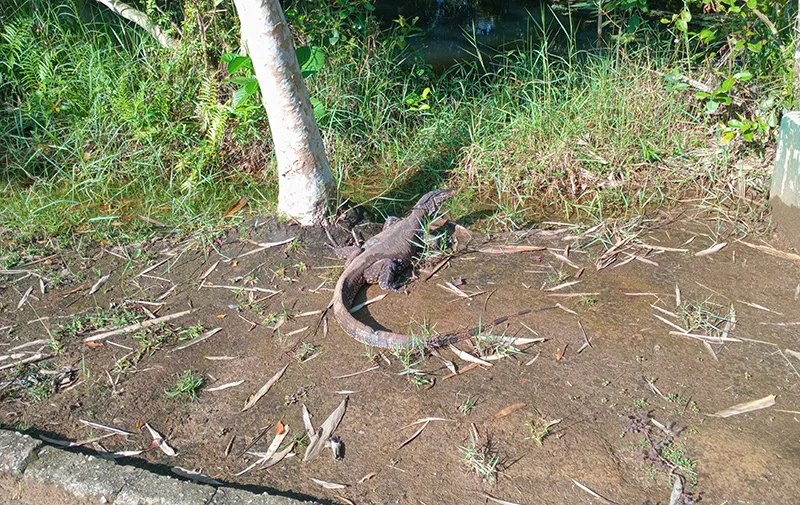
You may think sloth comes very easy,
To your kingly monitor of the shrinking marsh,
As he lies basking smugly in the morn sun,
But he is organized and alert all the while,
As he awaits his prey with patience infinite,
Free of malice, a professional of a kind,
His cumbrous body not slowing his sprite….
But note, he’s no conspirator spitting guile,
And doesn’t turn nasty unless crossed,
Nor by vengeful plans is he constantly dogged,
Unlike those animals of a more rational kind,
Whose ways have left behind a state so sorry.
By Lynn Ockersz
Midweek Review
Rajiva on Batalanda controversy, govt.’s failure in Geneva and other matters

Former President Ranil Wickremesinghe’s recent interview with Mehdi Hasan on Al Jazeera’s ‘Head-to-Head’ series has caused controversy, both in and outside Parliament, over the role played by Wickremesinghe in the counter-insurgency campaign in the late’80s.
The National People’s Power (NPP) seeking to exploit the developing story to its advantage has ended up with egg on its face as the ruling party couldn’t disassociate from the violent past of the JVP. The debate on the damning Presidential Commission report on Batalanda, on April 10, will remind the country of the atrocities perpetrated not only by the UNP, but as well as by the JVP.
The Island sought the views of former outspoken parliamentarian and one-time head of the Government Secretariat for Coordinating the Peace Process (SCOPP) Prof. Rajiva Wijesinha on a range of issues, with the focus on Batalanda and the failure on the part of the war-winning country to counter unsubstantiated war crimes accusations.
Q:
The former President and UNP leader Ranil Wickremesinghe’s interview with Al Jazeera exposed the pathetic failure on the part of Sri Lanka to address war crimes accusations and accountability issues. In the face of aggressive interviewer Mehdi Hasan on ‘Head-to-Head,’ Wickremesinghe struggled pathetically to counter unsubstantiated accusations. Six-time Premier Wickremesinghe who also served as President (July 2022-Sept. 2024) seemed incapable of defending the war-winning armed forces. However, the situation wouldn’t have deteriorated to such an extent if President Mahinda Rajapaksa, who gave resolute political leadership during that war, ensured a proper defence of our armed forces in its aftermath as well-choreographed LTTE supporters were well in place, with Western backing, to distort and tarnish that victory completely. As wartime Secretary General of the Government’s Secretariat for Coordinating the Peace Process (since June 2007 till the successful conclusion of the war) and Secretary to the Ministry of Disaster Management and Human Rights (since Jun 2008) what do you think of Wickremesinghe’s performance?
A:
It made him look very foolish, but this is not surprising since he has no proper answers for most of the questions put to him. Least surprising was his performance with regard to the forces, since for years he was part of the assault forces on the successful Army, and expecting him to defend them is like asking a fox to stand guard on chickens.
Q:
In spite of trying to overwhelm Wickremesinghe before a definitely pro-LTTE audience at London’s Conway Hall, Hasan further exposed the hatchet job he was doing by never referring to the fact that the UNP leader, in his capacity as the Yahapalana Premier, co-sponsored the treacherous Geneva Resolution in Oc., 2015, against one’s own victorious armed forces. Hasan, Wickremesinghe and three panelists, namely Frances Harrison, former BBC-Sri Lanka correspondent, Director of International Truth and Justice Project and author of ‘Still Counting the Dead: Survivors of Sri Lanka’s Hidden War,’ Dr. Madura Rasaratnam, Executive Director of PEARL (People for Equality and Relief in Lanka) and former UK and EU MP and Wickremesinghe’s presidential envoy, Niranjan Joseph de Silva Deva Aditya, never even once referred to India’s accountability during the programme recorded in late February but released in March. As a UPFA MP (2010-2015) in addition to have served as Peace Secretariat Chief and Secretary to the Disaster Management and Human Rights Ministry, could we discuss the issues at hand leaving India out?
A:
I would not call the interview a hatchet job since Hasan was basically concerned about Wickremesinghe’s woeful record with regard to human rights. In raising his despicable conduct under Jayewardene, Hasan clearly saw continuity, and Wickremesinghe laid himself open to this in that he nailed his colours to the Rajapaksa mast in order to become President, thus making it impossible for him to revert to his previous stance. Sadly, given how incompetent both Wickremesinghe and Rajapaksa were about defending the forces, one cannot expect foreigners to distinguish between them.
Q:
You are one of the many UPFA MPs who backed Maithripala Sirisena’s candidature at the 2015 presidential election. The Sirisena-Wickremesinghe duo perpetrated the despicable act of backing the Geneva Resolution against our armed forces and they should be held responsible for that. Having thrown your weight behind the campaign to defeat Mahinda Rajapaksa’s bid to secure a third term, did you feel betrayed by the Geneva Resolution? And if so, what should have the Yahapalana administration done?
A:
By 2014, given the total failure of the Rajapaksas to deal firmly with critiques of our forces, resolutions against us had started and were getting stronger every year. Mahinda Rajapaksa laid us open by sacking Dayan Jayatilleke who had built up a large majority to support our victory against the Tigers, and appointed someone who intrigued with the Americans. He failed to fulfil his commitments with regard to reforms and reconciliation, and allowed for wholesale plundering, so that I have no regrets about working against him at the 2015 election. But I did not expect Wickremesinghe and his cohorts to plunder, too, and ignore the Sirisena manifesto, which is why I parted company with the Yahapalanaya administration, within a couple of months.
I had expected a Sirisena administration to pursue some of the policies associated with the SLFP, but he was a fool and his mentor Chandrika was concerned only with revenge on the Rajapaksas. You cannot talk about betrayal when there was no faith in the first place. But I also blame the Rajapaksas for messing up the August election by attacking Sirisena and driving him further into Ranil’s arms, so that he was a pawn in his hands.
Q:
Have you advised President Mahinda Rajapaksa’s government how to counter unsubstantiated war crimes allegations propagated by various interested parties, particularly the UN, on the basis of the Panel of Experts (PoE) report released in March 2011? Did the government accept your suggestions/recommendations?
A:
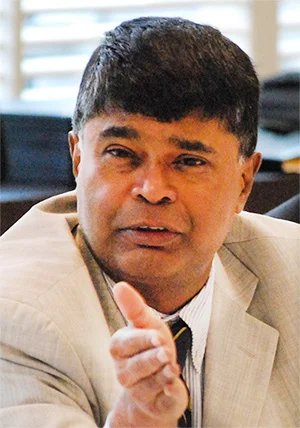
Prof. Rajiva Wijesinha
I kept trying, but Mahinda was not interested at all, and had no idea about how to conduct international relations. Sadly, his Foreign Minister was hanging around behind Namal, and proved incapable of independent thought, in his anxiety to gain further promotion. And given that I was about the only person the international community, that was not prejudiced, took seriously – I refer to the ICRC and the Japanese with whom I continued to work, and, indeed, the Americans, until the Ambassador was bullied by her doctrinaire political affairs officer into active undermining of the Rajapaksas – there was much jealousy, so I was shut out from any influence.
But even the admirable effort, headed by Godfrey Gunatilleke, was not properly used. Mahinda Rajapaksa seemed to me more concerned with providing joy rides for people rather than serious counter measures, and representation in Geneva turned into a joke, with him even undermining Tamara Kunanayagam, who, when he supported her, scored a significant victory against the Americans, in September 2011. The Ambassador, who had been intriguing with her predecessor, then told her they would get us in March, and with a little help from their friends here, they succeeded.
Q:
As the writer pointed out in his comment on Wickremesinghe’s controversial Al Jazeera interview, the former Commander-in-Chief failed to mention critically important matters that could have countered Hasan’ s line of questioning meant to humiliate Sri Lanka?
A:
How could you have expected that, since his primary concern has always been himself, not the country, let alone the armed forces?
Q:
Do you agree that Western powers and an influential section of the international media cannot stomach Sri Lanka’s triumph over separatist Tamil terrorism?
A:
There was opposition to our victory from the start, but this was strengthened by the failure to move on reconciliation, creating the impression that the victory against the Tigers was seen by the government as a victory against Tamils. The failure of the Foreign Ministry to work with journalists was lamentable, and the few exceptions – for instance the admirable Vadivel Krishnamoorthy in Chennai or Sashikala Premawardhane in Canberra – received no support at all from the Ministry establishment.
Q:
A couple of months after the 2019 presidential election, Gotabaya Rajapaksa declared his intention to withdraw from the Geneva process. On behalf of Sri Lanka that announcement was made in Geneva by the then Foreign Minister Dinesh Gunawardena, who became the Premier during Wickremesinghe’s tenure as the President. That declaration was meant to hoodwink the Sinhala community and didn’t alter the Geneva process and even today the project is continuing. As a person who had been closely involved in the overall government response to terrorism and related matters, how do you view the measures taken during Gotabaya Rajapaksa’s short presidency to counter Geneva?
A:
What measures? I am reminded of the idiocy of the responses to the Darusman report by Basil and Gotabaya Rajapaksa, who went on ego trips and produced unreadable volumes trying to get credit for themselves as to issues of little interest to the world. They were planned in response to Darusman, but when I told Gotabaya that his effort was just a narrative of action, he said that responding to Darusman was not his intention. When I said that was necessary, he told me he had asked Chief-of-Staff Roshan Goonetilleke to do that, but Roshan said he had not been asked and had not been given any resources.
My own two short booklets which took the Darusman allegations to pieces were completely ignored by the Foreign Ministry.
Q:
Against the backdrop of the Geneva betrayal in 2015 that involved the late Minister Mangala Samaraweera, how do you view President Wickremesinghe’s response to the Geneva threat?
A: Wickremesinghe did not see Geneva as a threat at all. Who exactly is to blame for the hardening of the resolution, after our Ambassador’s efforts to moderate it, will require a straightforward narrative from the Ambassador, Ravinatha Ariyasinha, who felt badly let down by his superiors. Geneva should not be seen as a threat, since as we have seen follow through is minimal, but we should rather see it as an opportunity to put our own house in order.
Q:
President Anura Kumara Dissanayake recently questioned both the loyalty and professionalism of our armed forces credited with defeating Northern and Southern terrorism. There hadn’t been a previous occasion, a President or a Premier, under any circumstances, questioned the armed forces’ loyalty or professionalism. We cannot also forget the fact that President Dissanayake is the leader of the once proscribed JVP responsible for death and destruction during 1971 and 1987-1990 terror campaigns. Let us know of your opinion on President Dissanayake’s contentious comments on the armed forces?
A: I do not see them as contentious, I think what is seen as generalizations was critiques of elements in the forces. There have been problems, as we saw from the very different approach of Sarath Fonseka and Daya Ratnayake, with regard to civilian casualties, the latter having planned a campaign in the East which led to hardly any civilian deaths. But having monitored every day, while I headed the Peace Secretariat, all allegations, and obtained explanations of what happened from the forces, I could have proved that they were more disciplined than other forces in similar circumstances.
The violence of the JVP and the LTTE and other such groups was met with violence, but the forces observed some rules which I believe the police, much more ruthlessly politicized by Jayewardene, failed to do. The difference in behaviour between the squads led for instance by Gamini Hettiarachchi and Ronnie Goonesinghe makes this clear.
Q:
Mehdi Hasan also strenuously questioned Wickremesinghe on his role in the UNP’s counter-terror campaign during the 1987-1990 period. The British-American journalists of Indian origins attacked Wickremesinghe over the Batalanda Commission report that had dealt with extra-judicial operations carried out by police, acting on the political leadership given by Wickremesinghe. What is your position?
A:
Wickremesinghe’s use of thugs’ right through his political career is well known. I still recall my disappointment, having thought better of him, when a senior member of the UNP, who disapproved thoroughly of what Jayewardene had done to his party, told me that Wickremesinghe was not honest because he used thugs. In ‘My Fair Lady,’ the heroine talks about someone to whom gin was mother’s milk, and for Wickremesinghe violence is mother’s milk, as can be seen by the horrors he associated with.
The latest revelations about Deshabandu Tennakoon, whom he appointed IGP despite his record, makes clear his approval for extra-judicial operations.
Q:
Finally, will you explain how to counter war crimes accusations as well as allegations with regard to the counter-terror campaign in the’80s?
A:
I do not think it is possible to counter allegations about the counter-terror campaign of the eighties, since many of those allegations, starting with the Welikada Prison massacre, which Wickremesinghe’s father admitted to me the government had engendered, are quite accurate. And I should stress that the worst excesses, such as the torture and murder of Wijeyedasa Liyanaarachchi, happened under Jayewardene, since there is a tendency amongst the elite to blame Premadasa. He, to give him his due, was genuine about a ceasefire, which the JVP ignored, foolishly in my view though they may have had doubts about Ranjan Wijeratne’s bona fides.
With regard to war crimes accusations, I have shown how, in my ‘Hard Talk’ interview, which you failed to mention in describing Wickeremesinghe’s failure to respond coherently to Hasan. The speeches Dayan Jayatilleke and I made in Geneva make clear what needed and still needs to be done, but clear sighted arguments based on a moral perspective that is more focused than the meanderings, and the frequent hypocrisy, of critics will not now be easy for the country to furnish.
By Shamindra Ferdinando
-
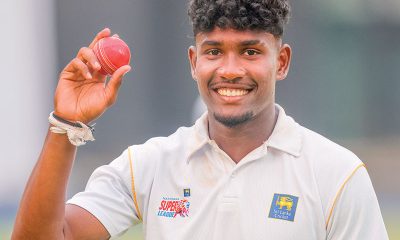
 Sports2 days ago
Sports2 days agoSri Lanka’s eternal search for the elusive all-rounder
-

 Features6 days ago
Features6 days agoCelebrating 25 Years of Excellence: The Silver Jubilee of SLIIT – PART I
-

 Business6 days ago
Business6 days agoCEB calls for proposals to develop two 50MW wind farm facilities in Mullikulam
-
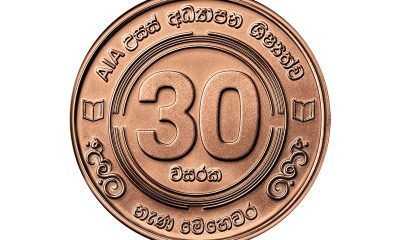
 Business4 days ago
Business4 days agoAIA Higher Education Scholarships Programme celebrating 30-year journey
-
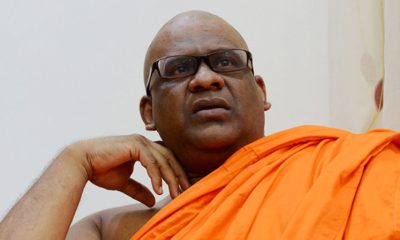
 News3 days ago
News3 days agoGnanasara Thera urged to reveal masterminds behind Easter Sunday terror attacks
-
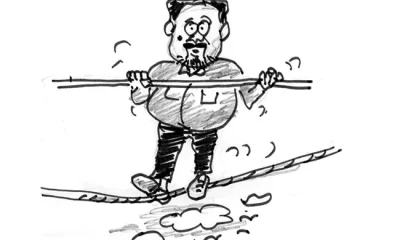
 Features6 days ago
Features6 days agoNotes from AKD’s Textbook
-
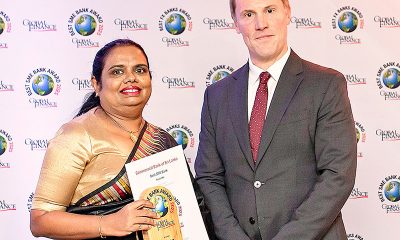
 News2 days ago
News2 days agoComBank crowned Global Finance Best SME Bank in Sri Lanka for 3rd successive year
-
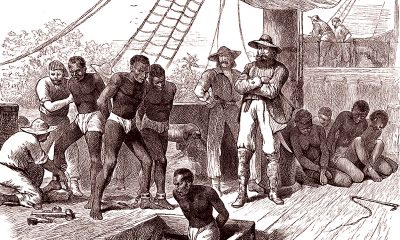
 Features2 days ago
Features2 days agoSanctions by The Unpunished






